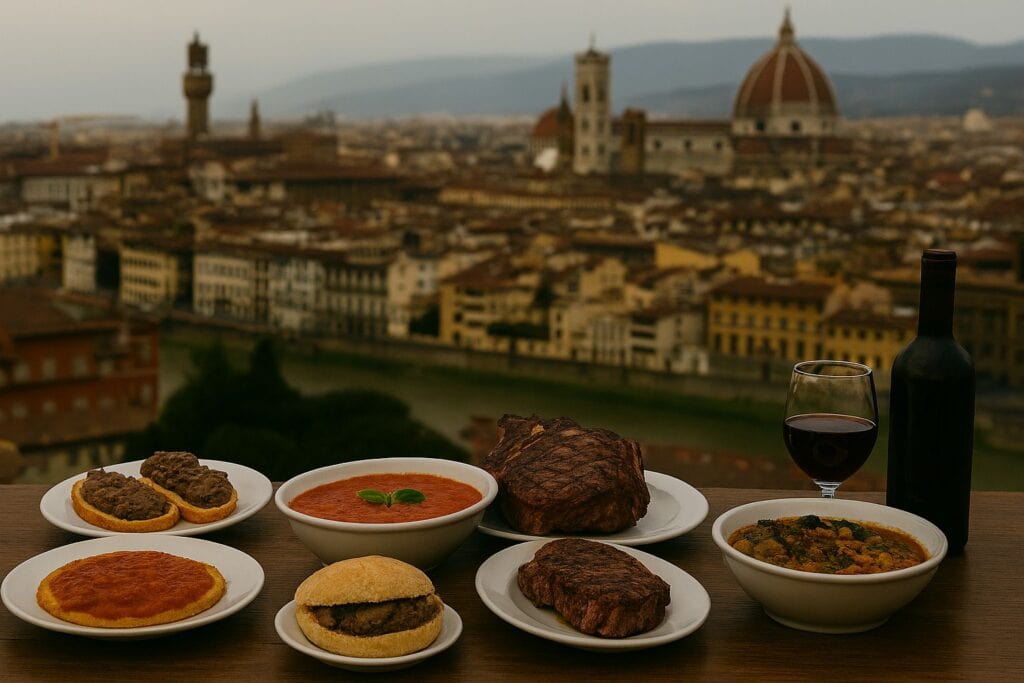The Florentine cuisine is the authentic soul of our city: born from peasant wisdom and the need not to waste anything, it has transformed poor ingredients into dishes rich in flavor and tradition. In our historic trattorie, as in the neighborhood markets, you can still breathe the atmosphere of a Florence that knows how to honor its roots.
Florence not only enchants with its artistic masterpieces, but also with a culinary tradition that tells five centuries of history.
Get ready to discover the secrets of a gastronomy that has conquered the world while remaining deeply linked to the Tuscan land.
The typical dishes of Florence to know and taste
Every time I accompany visitors to discover the real Florence, I inevitably take them to the table. Because our city is told through the flavors: from the appetizer served with Tuscan unsalted bread, to the desserts that smell of tradition. Each dish has its own story, each recipe holds secrets handed down from grandmothers.
Here are the 13 dishes you absolutely cannot miss if you want to know the true gastronomic soul of Florence.
1. Tuscan Crostini
The first taste of authentic Florence always starts with chicken liver crostini. On slices of Tuscan bread – strictly unsalted – we spread a velvety cream prepared with chicken livers, anchovies, capers and a touch of white wine. In the most traditional Florentine families, each grandmother has her own secret recipe: some add a hint of sage, others prefer a drop of brandy. This appetizer is born from the “nothing is thrown away” philosophy that characterizes our cuisine, transforming offal into a delicacy that also captivates the most refined palates.
2. Fettunta
The fettunta is culinary poetry in its purest form. A thick slice of homemade bread, toasted over the embers, rubbed with garlic and drenched in freshly pressed olive oil. The best time to enjoy it? During the “new olive oil festival” between November and December, when the just-pressed extra virgin olive oil has that characteristic pungency that is described as “spicy.” In the olive presses of the hills around the city, you can still see olive growers tasting the oil just like that, on a simple slice of bread.
3. Pappa al pomodoro
“Pappa col pomodoro” sang Rita Pavone, but we Florentines simply call it “pappa”. It is the quintessential dish of nostalgia: stale bread, ripe tomatoes, basil and a drizzle of olive oil. The consistency must be perfect – neither too liquid nor too thick. The secret? The bread must “dissolve” completely, creating a homogeneous cream that smells of summer. In our homes, it is the comfort dish, the one that mothers prepare when they want to pamper the family.
4. Panzanella
The Florentine summer has the taste of panzanella. This dish originates from the need to refresh during the hot months using stale bread. The bread is softened in fresh water, then wrung out and seasoned with ripe tomatoes, crunchy cucumbers, red onions from Tropea, and fragrant basil. The name, according to popular tradition, derives from the “zanella”, the earthenware bowl in which it was served. Today it can be found in every city trattoria, but the most authentic version is the one prepared by families during Sunday picnics.
5. Ribollita
Ribollita is the symbol of Florentine recovery cuisine. This thick and flavorful soup is prepared with kale, cannellini beans, stale bread, and seasonal vegetables. The name says it all: after the first cooking, it is literally “reboiled” the next day, when the flavors have blended perfectly. In some historic taverns, some chefs still prepare the ribollita in the traditional terracotta “pignatto”, following recipes that have not changed for centuries.
6. Florentine Steak
The undisputed queen of our tables: the Florentine steak. It must be obtained from the loin of the Chianina breed veal, at least two fingers thick and cooked strictly rare on the charcoal embers. We do not accept compromises: salt, pepper and a drizzle of oil only after cooking. It is a ritual that brings the whole table together, to be shared in company as was once done in the popular taverns.
7. Lampredotto
The specialty of Florentine street food, Lampredotto. It is a part of the bovine stomach (abomasum), slowly boiled with tomato, celery, onion and bay leaf. It can be found in the characteristic “carts” scattered around the city, where the “lampredottai” – true street artists – serve it in a sandwich with spicy green sauce. Piazza dei Ciompi, the Sant’Ambrogio Market, Via de’ Macci: every corner has its historic “lampredottaio”. A tip: always ask for “with the sauce” and don’t be afraid to get your hands dirty!
8. Florentine Tripe
Florentine Tripe is another pillar of our popular tradition. Cut into thin strips, it is cooked in a stew with tomato, celery, carrot and the aroma, then served with a generous sprinkling of Tuscan pecorino. It’s a divisive dish: you either love it passionately or can’t stand it, but it’s as much a part of the Florentine culinary identity as Michelangelo’s David.
9. Peposo all’Imprunetina
This legendary stew comes from the small town of Impruneta, famous for its terracotta. The brick makers would cook the beef in abundant red wine and black pepper, taking advantage of the heat from the always-burning kilns. The result is a meltingly tender meat with an intense, spicy flavor. Some inns in the Florentine hills still cook it in the traditional Impruneta terracotta pots, respecting the slow cooking that makes it inimitable.
10. Cantucci
The perfect ending to any Florentine meal. Cantucci are crisp almond biscuits, sliced diagonally after their first bake. Tradition calls for dipping them in Vin Santo, our sweet, amber-colored dessert wine. In the convents of the Florentine countryside, nuns still bake these biscuits using age-old recipes. The dipping moment is sacred: the cantuccio is left in the glass just long enough to soften without falling apart.
11. Florentine schiacciata
The Florentine Carnival is scented with sweet schiacciata. This soft and delicate cake, dusted with powdered sugar and decorated with the Florentine lily in cocoa, is the pride of our historic pastry shops. Each establishment has its own version. The secret lies in the softness: it must be so soft that it melts in the mouth, leaving a delicate aroma of vanilla and lemon.
12. Tuscan Savory Schiacciata
Our daily flatbread, present in every bakery in the city. Low, golden and crispy on the surface, soft inside. We enjoy it for breakfast with a… cappuccino, a snack filled with finocchiona, or as an accompaniment to meals. In the local markets, bakers still bake it hot several times a day. The secret? The Tuscan extra virgin olive oil that gives it that unmistakable flavor and perfect crunchiness.
13. Flatbread with grapes
September in Florence smells of grape harvest and flatbread with grapes. This rustic sweet celebrates the grape season with a simple dough enriched with black grapes, sugar and sometimes wild fennel seeds. In the countryside around the city, it was tradition to prepare it during the harvest, using the most beautiful grapes
The Florentine table is just the beginning of the journey to Florence. Every dish I have told you about has deep roots in the streets you walk on, the stones you can touch, and the traditions that still animate our neighborhoods today.
I suggest discovering the historic markets where these flavors are born, the artisan workshops that preserve ancient crafts, and the popular festivals that celebrate our identity. Because truly knowing Florence means embracing all its authenticity: what you taste, see, breathe and live every day on its streets.


